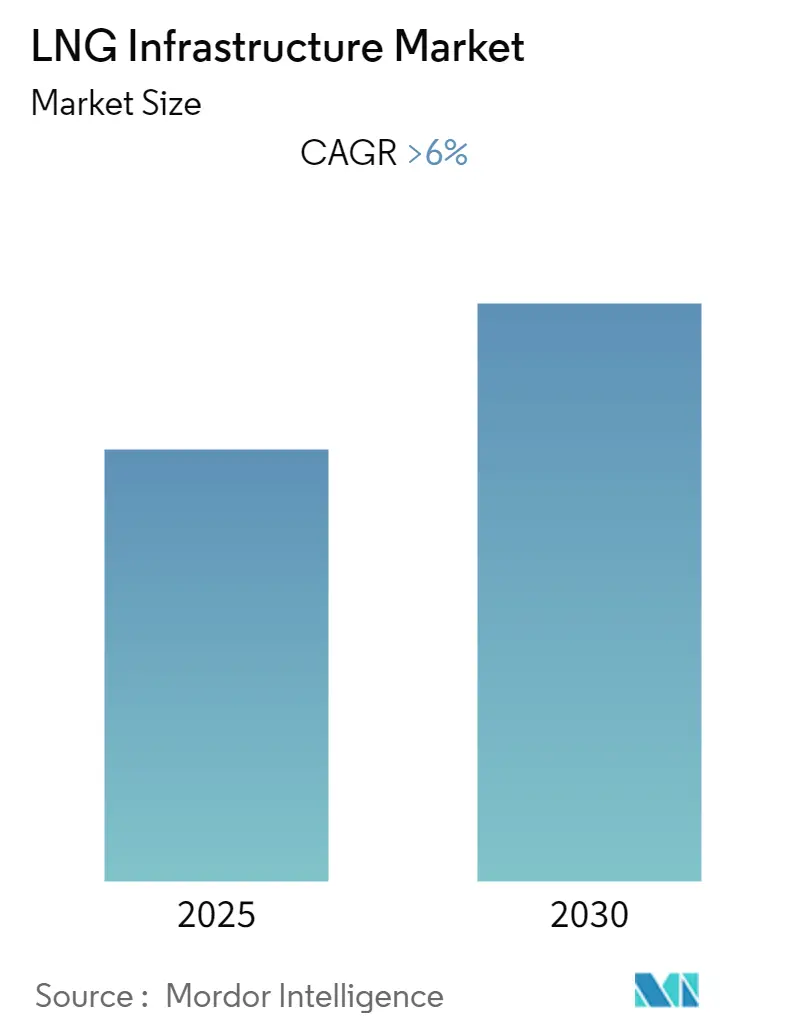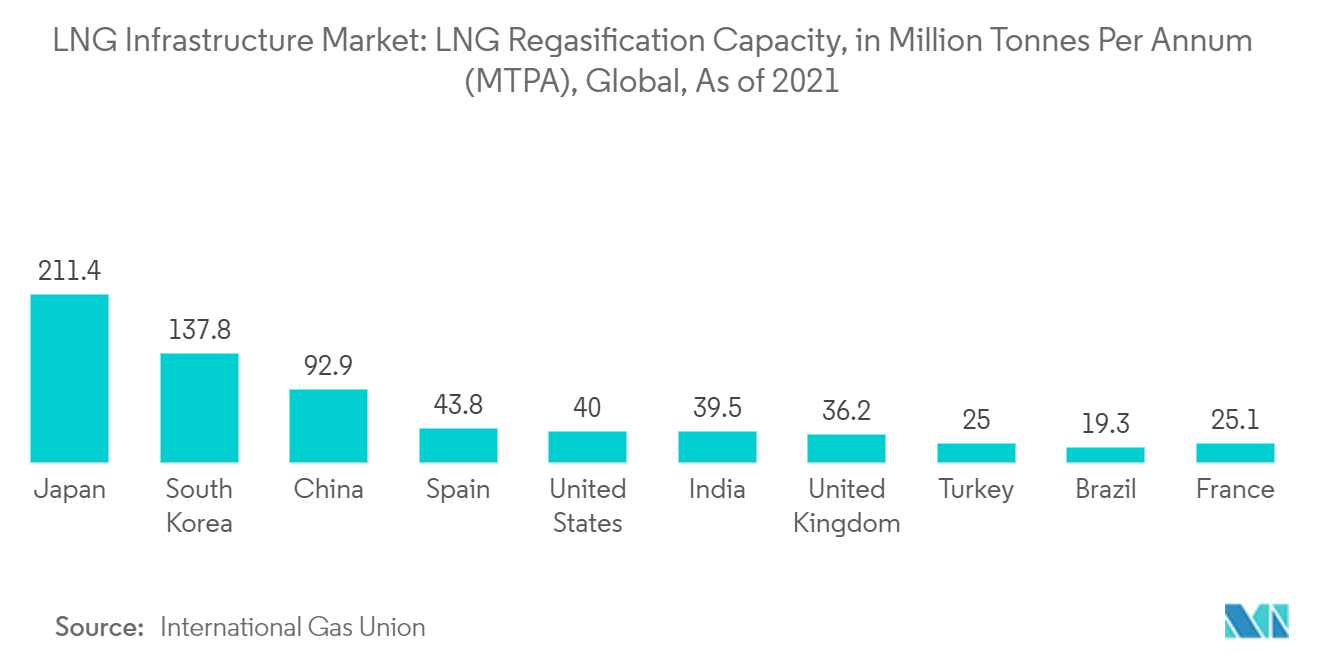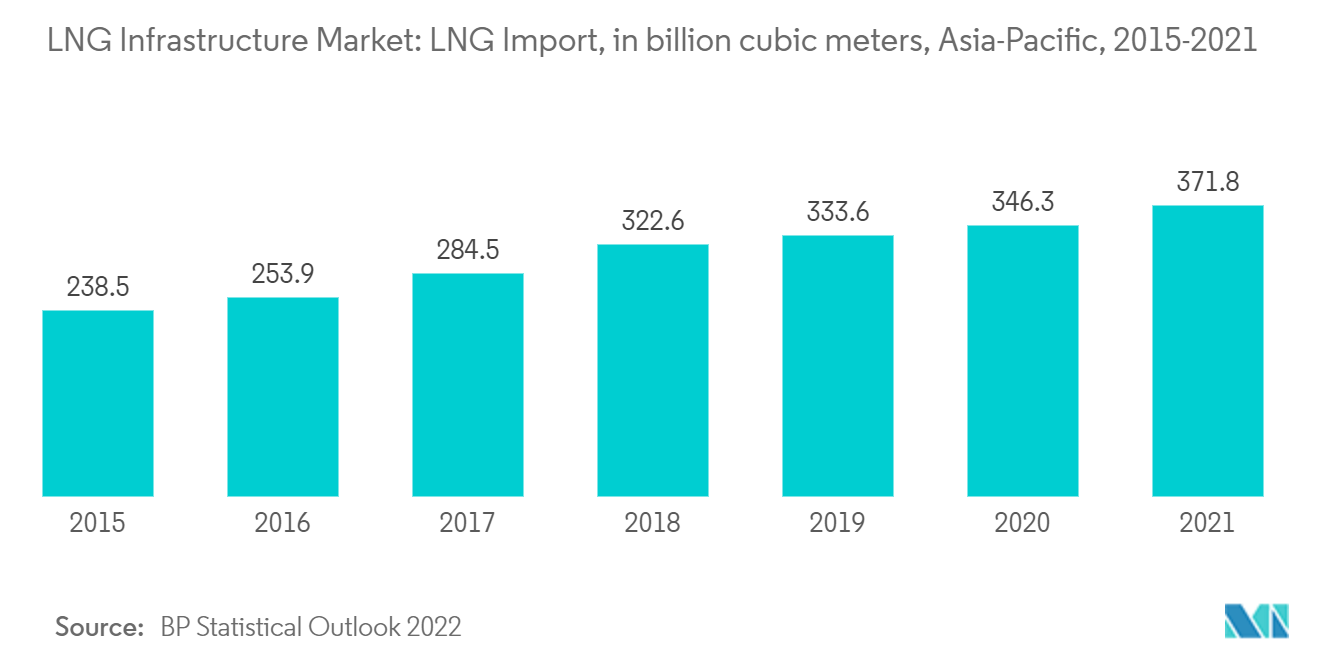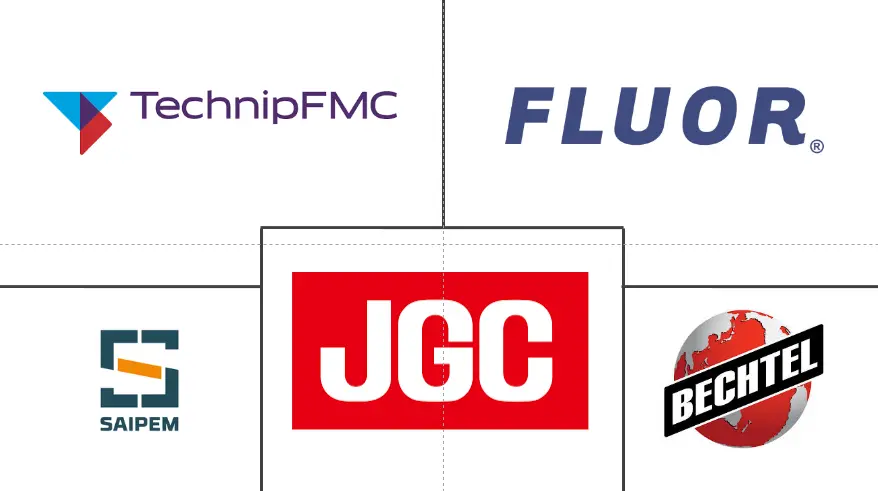
LNG Infrastructure Market Analysis
The LNG Infrastructure Market is expected to register a CAGR of greater than 6% during the forecast period.
In 2020, COVID-19 had a detrimental effect on the market. Presently, the market has reached pre-pandemic levels.
- Over the medium period, the market drivers for LNG infrastructure include the growing uses of natural gas in various sectors, such as power, to have lower carbon emissions and the investments that nations around the world are making in having a cleaner environment.
- On the other hand, alternative sources of energy, such as nuclear energy production and renewable technology developments in various regions, may act as a restraint for the market's growth during the forecast period.
- Nevertheless, as per the Energy Information Administration (EIA), non-OECD Asian countries like China, India, Bangladesh, Thailand, and Vietnam are expected to consume 120 billion cubic feet per day (bcf/d) of natural gas by 2050, outpacing regional natural gas production by 50 bcf/d. The supply imbalance in the region is likely to result in increasing dependency on other regions, which is expected to create an opportunity for the LNG infrastructure companies to penetrate markets.
- Asia-Pacific is expected to dominate the LNG infrastructure market with the presence of both liquefaction and regasification terminals. Countries such as Australia, Indonesia, and Malaysia have the highest capacity liquefaction terminals, while Japan, South Korea, China, and India have the highest capacity infrastructure for the regasification of LNG.
LNG Infrastructure Market Trends
Regasification LNG Terminals is Expected to Dominate the Market
- Regasification LNG terminals are expected to dominate the market, and with the addition of upcoming LNG regasification terminals in China and India, Asia-Pacific is expected to remain the dominant market in the LNG infrastructure market.
- The cost of LNG terminals varies depending on the technology and location of deployment or installation. Generally, the capital expenditure of the LNG terminal normally costs around USD 180 million per million metric tons of LNG, while its operating cost varies from USD 90,000-100,000 per day.
- In 2021, Japan, South Korea, China, and Spain dominated the market with a large capacity of LNG regasification terminals. Japan's regasification capacity for LNG accounted for 211.4 million metric tons per year in 2021, the highest in the world.
- Many countries are now focusing on floating LNG terminals. For instance, in July 2022, the first floating terminal for liquefied natural gas (LNG) in India is set to open in Jaigarh, Maharashtra. The floating storage and regasification units (FSRUs) at Jaigarh and the Swan Energy-led terminal at Jafrabad are planned to increase regasification capacity by 11 million metric tons per annum (mtpa).
- Additionally, in January 2023, a floating terminal for the import of liquefied natural gas (LNG) arrived in Brunsbüttel, the third such vessel to arrive in recent weeks as Germany seeks to diversify away from its previous top supplier, Russia. The floating storage and regasification unit (FSRU) Hoegh Gannet arrived at the Brunsbuettel Elbe Hafen port near Hamburg. It will let LNG tankers land and have their supplies regasified and fed into the country's power system.
- As the LNG trade grows day by day around the world, demand for LNG regasification infrastructure is expected to increase in the future. According to the BP Statistics Review 2022, the total LNG imports in the world accounted for 516.2 billion cubic meters, with an annual growth rate of 5.6% as compared to the previous year.
- Thus, owing to the recent LNG regasification projects and increasing LNG imports, regasification LNG terminals are expected to dominate the market.

Asia-Pacific to Dominate the Market
In 2021, China was expected to be one of the major countries in the world, which would lead to growth in LNG demand. According to the International Gas Union, China accelerated its policy of reducing emissions and pollution through coal-to-gas conversion, increasing its LNG demand by 15.0%. Several other Asian countries and areas increased LNG imports significantly in 2021, notably South Korea (+15.0%) and Chinese Taipei (+9.5%).
With the increasing adoption of natural gas over coal for power generation, prominent players and small power project companies with no access to remote locations or pipeline facilities are expected to import LNG. They have been showing interest in investing in LNG facilities. The number of LNG receiving terminals in China is expected to increase with the growing share of LNG in the power sector. Several small power plants near the Yangtze River import LNG directly from small vessels and use it for power generation. China is anticipated to import about 25 MTPA of LNG by 2030.
Moreover, many city gas distribution companies in India plan to develop CNG or satellite stations. Moreover, the Government of India plans to add fueling stations along its 6,000-km-long golden quadrilateral highways to build an effective ecosystem for LNG-fueled vehicles. This will likely increase the demand for LNG regasification terminals to ensure an uninterrupted gas supply for transportation applications.
As per the Energy Information Administration (EIA), non-OECD Asian countries like China, India, Bangladesh, Thailand, and Vietnam are expected to consume 120 billion cubic feet per day (bcf/d) of natural gas by 2050, outpacing regional natural gas production by 50 bcf/d.
Thus, with increasing consumption as well as imports of LNG, the use of LNG infrastructure is likely to be in demand in the forecast period. According to the BP Statistics Review 2022, the total LNG import of the Asia-Pacific accounted for 371.8 billion cubic meters, which is approximately 72% of the total world's import, with an annual growth rate of 7.7% as compared to the previous year.
Small-scale LNG is in a very nascent stage in India; however, there are a few LNG stations for which LNG transportation through LNG trucks is taking place. With the intention of increasing the share of natural gas to 15% in its energy mix by 2030, India is likely to construct small-scale LNG facilities for natural gas supply to remote places with no pipeline infrastructure. For instance, in June 2022, GAIL Limited, a government-owned natural gas explorer and producer company, aimed to set up small liquefaction facilities for areas not connected to LNG pipelines. Furthermore, GAIL is likely to set up two small-scale liquefaction plants on a pilot basis.
Thus, with the upcoming LNG terminal projects and increasing LNG import capacity, the region is expected to dominate the market in the forecast period.

LNG Infrastructure Industry Overview
The LNG infrastructure market is fragmented. The key players in the LNG infrastructure market (not in a particular order) include TechnipFMC plc, Fluor Corporation, Saipem SpA, JGC Holdings Corporation, and Bechtel Corporation, among others.
LNG Infrastructure Market Leaders
-
JGC Holdings Corporation
-
Bechtel Corporation
-
Fluor Corporation
-
TechnipFMC plc
-
Saipem SpA
- *Disclaimer: Major Players sorted in no particular order
LNG Infrastructure Market News
- March 2023: The German government intends to build massive LNG infrastructure to maintain European supply security. The German government sees a need for large overcapacity in LNG imports to ensure the region's supply in the event of accidents or sabotage to any of its infrastructure, such as pipelines from Norway.
- January 2023: BP sent a floating processing center for liquefied natural gas from a Chinese shipyard to the coast of West Africa. A floating production, storage, and offloading vessel is going to be moored about 25 miles offshore to serve as a facility to process liquefied natural gas.
- June 2022: Novatek signed small-scale LNG cooperation agreements with the Moscow and Samara region's governments as part of the St. Petersburg International Economic Forum. The parties were looking to expand the use of LNG as motor fuel and gas supply to off-grid customers, including the construction of small-scale LNG plants and relevant sales infrastructure.
LNG Infrastructure Industry Segmentation
LNG infrastructure refers to the facilities and systems that are used for the production, transportation, storage, and distribution of liquefied natural gas (LNG). The LNG infrastructure typically includes natural gas processing plants, liquefaction plants, storage tanks, marine terminals, and regasification plants.
The LNG infrastructure market is segmented by type and geography (North America, Asia-Pacific, Europe, South America, the Middle East, and Africa). By type, the market is segmented into regasification terminals and liquefaction terminals. The report also covers the market size and forecasts for the LNG infrastructure market across major regions. For each segment, market sizing and forecasts have been done based on CAPEX (USD billion).
| Type | Regasification Terminal | ||
| Liquefication Terminal | |||
| Geography | North America | United States | |
| Canada | |||
| Mexico | |||
| Europe | Germany | ||
| France | |||
| Spain | |||
| United Kingdom | |||
| Rest of Europe | |||
| Asia-Pacifc | China | ||
| India | |||
| Japan | |||
| South Korea | |||
| Rest of Asia-Pacifc | |||
| South America | Brazil | ||
| Argentina | |||
| Rest of South America | |||
| Middle East and Africa | United Arab Emirates | ||
| Saudi Arabia | |||
| Rest of Middle East and Africa | |||
LNG Infrastructure Market Research FAQs
What is the current LNG Infrastructure Market size?
The LNG Infrastructure Market is projected to register a CAGR of greater than 6% during the forecast period (2025-2030)
Who are the key players in LNG Infrastructure Market?
JGC Holdings Corporation, Bechtel Corporation, Fluor Corporation, TechnipFMC plc and Saipem SpA are the major companies operating in the LNG Infrastructure Market.
Which is the fastest growing region in LNG Infrastructure Market?
Asia Pacific is estimated to grow at the highest CAGR over the forecast period (2025-2030).
Which region has the biggest share in LNG Infrastructure Market?
In 2025, the Asia Pacific accounts for the largest market share in LNG Infrastructure Market.
What years does this LNG Infrastructure Market cover?
The report covers the LNG Infrastructure Market historical market size for years: 2020, 2021, 2022, 2023 and 2024. The report also forecasts the LNG Infrastructure Market size for years: 2025, 2026, 2027, 2028, 2029 and 2030.
Our Best Selling Reports
LNG Infrastructure Industry Report
Statistics for the 2025 LNG Infrastructure market share, size and revenue growth rate, created by Mordor Intelligence™ Industry Reports. LNG Infrastructure analysis includes a market forecast outlook for 2025 to 2030 and historical overview. Get a sample of this industry analysis as a free report PDF download.


.webp)

